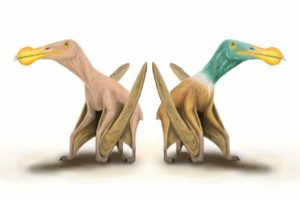
The debate about when dinosaurs developed feathers has taken a new turn with a paper refuting earlier claims that feathers were also found on dinosaurs’ relatives, the flying reptiles called pterosaurs.
Pterosaur expert Dr David Unwin from the University of Leicester’s Centre for Palaeobiology Research, and Professor Dave Martill, of the University of Portsmouth have examined the evidence that these creatures had feathers and believe they were in fact bald.
They have responded to a suggestion by a group of his colleagues led by Zixiao Yang that some pterosaur fossils show evidence of feather-like branching filaments, ‘protofeathers’, on the animal’s skin.
Dr Yang, from Nanjing University, and colleagues presented their argument in a 2018 paper in the journal Nature Ecology and Evolution. Now Unwin and Martill, have offered an alternative, non-feather explanation for the fossil evidence in the same journal.
While this may seem like academic minutiae, it actually has huge palaeontological implications. Feathered pterosaurs would mean that the very earliest feathers first appeared on an ancestor shared by both pterosaurs and dinosaurs, since it is unlikely that something so complex developed separately in two different groups of animals.
This would mean that the very first feather-like elements evolved at least 80 million years earlier than currently thought. It would also suggest that all dinosaurs started out with feathers, or protofeathers but some groups, such as sauropods, subsequently lost them again — the complete opposite of currently accepted theory.
The evidence rests on tiny, hair-like filaments, less than one tenth of a millimetre in diameter, which have been identified in about 30 pterosaur fossils. Among these, Yang and colleagues were only able to find just three specimens on which these filaments seem to exhibit a ‘branching structure’ typical of protofeathers.
Unwin and Martill propose that these are not protofeathers at all but tough fibres which form part of the internal structure of the pterosaur’s wing membrane, and that the ‘branching’ effect may simply be the result of these fibres decaying and unravelling.
Dr Unwin said: “The idea of feathered pterosaurs goes back to the nineteenth century but the fossil evidence was then, and still is, very weak. Exceptional claims require exceptional evidence — we have the former, but not the latter.”
Professor Martill noted that either way, palaeontologists will have to carefully reappraise ideas about the ecology of these ancient flying reptiles. He said, “If they really did have feathers, how did that make them look, and did they exhibit the same fantastic variety of colours exhibited by birds. And if they didn’t have feathers, then how did they keep warm at night, what limits did this have on their geographic range, did they stay away from colder northern climes as most reptiles do today. And how did they thermoregulate? The clues are so cryptic, that we are still a long way from working out just how these amazing animals worked.”
The paper “No protofeathers on pterosaurs” is published this week in Nature Ecology and Evolution.
Reference:
David M. Unwin, David M. Martill. No protofeathers on pterosaurs. Nature Ecology & Evolution, 2020; DOI: 10.1038/s41559-020-01308-9
Note: The above post is reprinted from materials provided by University of Portsmouth.










